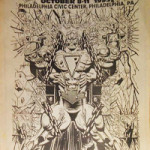A lot happen at Wizards of the Coast in the month following our return from Worldcon. As recent events had shown, Magic: the Gathering was proving to be popular, in fact more popular than had anticipated. When the original print run of approximately 10 million cards had been set, Peter Adkison had figured that would last a bit over six months. What happened instead was that the entire print run was sold out in less than six weeks.
This led to another problem. We were having the cards printed by a company out of Belgium called Cartamundi. This was the best possible printer we could have gone with, as they also print Bicycle poker cards. But we ran into a problem based on their business practices. After they had printed around 2.6 million of the cards they shut the equipment down for maintenance. This by itself would not have been that big a deal. No, the other problem was that in accordance with European tradition they then shut the company down for a month so that the entire staff could take holiday.
If Magic: the Gathering had simply had the popularity that Peter and Richard Garfield had anticipated this would not have been a big deal. But no, it had to go off and be a mega hit. So people were demanding cards, and we were still waiting on the remainder of the first print run.
Finally in October we got the remaining cards in that print run, and learned that we had one final issue to address. During the maintenance, Cartamundi had apparently fixed something in the card cutting process that was out of alignment. The result was that the corners of the cards were visibly different than those pre-maintenance. To Cartamundi this seemed to be no big deal; after all, with poker cards who cares if the corners of one deck are slightly different from another. But with Magic cards you are mixing together cards bought from many different decks. This was bad, because in game play you could tell the difference just by looking at the deck, and then you could put certain cards in with the different corners and know when you were going to get that card. Make it a game-changer card, and you have a strategic edge.
This is what led to the two parts of the print run coming to be known as Alpha and Beta. Rules had to be made for tournament play that if your deck had Alpha cards they all had to be Alpha. In later years card sleeves would be introduced that masked the corners and would allow Alphas in regular decks.
But coming into October we were still figuring this all out. And with these discussions we headed off to another convention. This time it was a comic book convention in Philadelphia, Comicfest, which was held October 8-11. As far as I can tell it was a onetime event, as I have found no other reference to a show called Comicfest in Philadelphia outside of 1993.
The crew for this this show was led by Peter Adkison and Lisa Stevens, who were there mostly to talk to industry people. Jesper Myrfors was there to look for new artists. A new addition to the company named Vic Wertz was with us; he did operations work for the company, and was going to work the booth mostly. Steve Bishop was with us as well, as by this time he had settled into the role of WotC tournament coordinator. And then there was me, and my job was to work the both and demo Magic.
Several people had shown up early to meet with people. In fact I think when I flew it was just Steve and I the night before the convention, so we did not have to deal with the preshow set up. Getting there we were greeted by Jesper with a warning not to eat at our hotel’s restaurant. He described it as a great place to eat if you wanted to learn all the different ways to serve botulism. So it was off to Denny’s we went.
Unlike the previous two conventions we had attended, it was decided that we could now afford to book enough rooms so that no one had to sleep on the floor. This was a great relief to everyone. Steve was additionally pleased to learn that our room was set up so that there was a main bedroom with its own door and a fold out in the main room. This meant he did not have to deal with my snoring, which, thanks to Ron Richardson, had gained legendary status.
Coming into the convention itself we were once again in a new position. This was a comic book convention, so as a game company we were a side item and so we had a booth that was a bit off to the side. It was slightly bigger than the ones we had at the previous conventions, but our neighbors were a video tape seller, a table promoting a comic book featuring a heroine based on a Playboy Playmate, and a group selling an independently produced parody of Spider-Man set in Jamaica.
Unlike Gen Con or Worldcon we were now becoming a known commodity; even in comic circles, since many comic shops who otherwise didn’t carry games were selling Magic: the Gathering. Other game companies were at the show, most notably TSR and White Wolf. At this point in time we were still considered a lower tier than either of these. But we were still drawing enough traffic to make the other tables around us a little jealous.
In the industry we were getting a bigger reputation as well, especially amongst artists. Jesper had made it his mission to not only make the art in Magic: the Gathering iconic, but to raise the status of the artists to superstar level. His goal was to make artists who worked in the industry stars and improve their overall position. He also wanted to make sure they were well-compensated for their work, and thus WotC had one of the best deals for artists signed to work on Magic, including retaining ownership of the original art. So naturally, at a comic book show, we had a lot of artists stop by to show Jesper their portfolios and see if they could get work. Not only would they come to our table, but Jesper would go out to seek out artists to see if he could find good ones that had not heard of us.
At one point during the first day, while only Vic and I were at the booth, one such aspiring artist approached.
“Hello,” he said with a British accent. “Who do I talk to about showing my art?”
I responded that Jesper was our art director but was away from the booth, and would be back in a while.
“Ok, can I leave a sample with you?”
“Sure.”
With that he handed me a comic book for which he had done the art. Remembering that I should be professional and personal, I figured I should make a proper introduction.
“I’m Jeff Harris by the way.”
“Hi, I’m Pete Venters.”
If you are a Magic: the Gathering fan you probably recognized his name right away, as Pete is the second most prolific artist in Magic, having illustrated 272 cards.
But if you have read this site for a while you will remember that I have made mention of my sister (again, not by blood, but my sister none the less) who runs the site Gothic Charm School. If you follow that site you know her name is Jillian Venters.
So not only was this how WotC came into contact with one of its most celebrated artists ever, it was the first meeting with my future brother-in-law, and one of my oldest friends.
At the time he was a guy I just met who handed me a vampire comic to show one of the bosses. I also took a card. We saw each other a couple of times throughout the show, and became at least acquaintances. He was around a lot at the end, as Jesper did like his art and was interested in using him.
There was another thing that separated this convention from the previous ones, Adkison had rented a car. So we were able to venture forth and see more of the city than just the area around the convention. This led to Lisa for some reason constantly doing a Rain Man impression that mostly consisted of her saying, “Excellent driver, Pete’s an excellent driver.” I have no idea how it started. The only reason I even remember it is that Pete took a wrong turn at one point onto a short one way street just as a cop passed us. This resulted in everyone in the car, myself included, doing the impression.
Overall the convention was a good one. We made good contacts and the response to the game in the comics market looked strong.
Due to the way the flights had been booked, Pete Adkison, Steve, and I ended up having an extra day in Philadelphia. Pete had arranged some meetings, but Steve and I really had nothing to do.
Well, nothing official. Steve had a plan.
All weekend Steve had been talking about wanting to visit The Mütter Museum. This is a museum of medical oddities. It includes a collection of skulls used to prove there is no racial predisposition in brain development, a nine foot long human colon, the conjoined livers of the Siamese twins the condition is named after, and many others points of interest, most of them gruesome.
After that, we went to a place we were both interested in, Independence National Historical Park. This is where Independence Hall is located, as well as the Liberty Bell. I have a great love of the history surrounding the Founding Fathers, so I was very interested in visiting. Steve on the other hand, while also interested, was a dedicated smart ass. When the one of the park rangers was giving us a history of the Liberty Bell and took questions, Steve asked, “How many slaves died during its construction?” His logic was that this is how you rated any monument. I made it clear that I had no idea who he was or why he was standing with me.
It was a great time.
And thus concludes my third convention for WotC.
Next time, in the wake of an unprecedented event I find myself overseas and without pajamas.







 Today I would like to introduce you to the band Rock Sugar.
Today I would like to introduce you to the band Rock Sugar.

